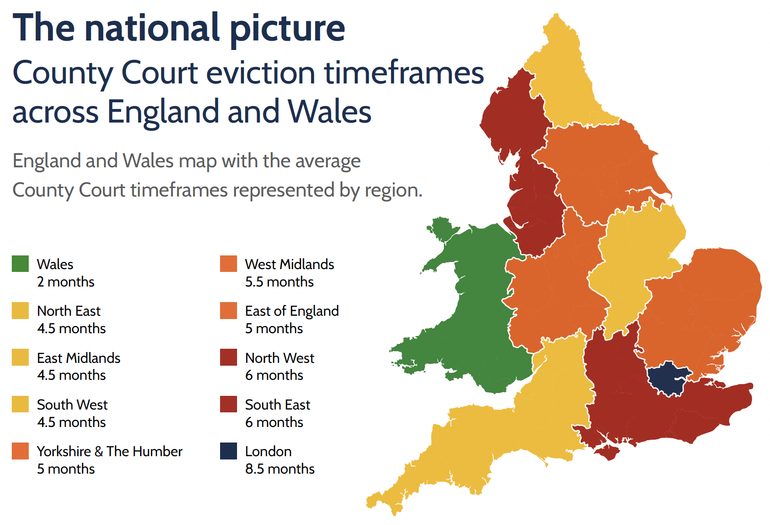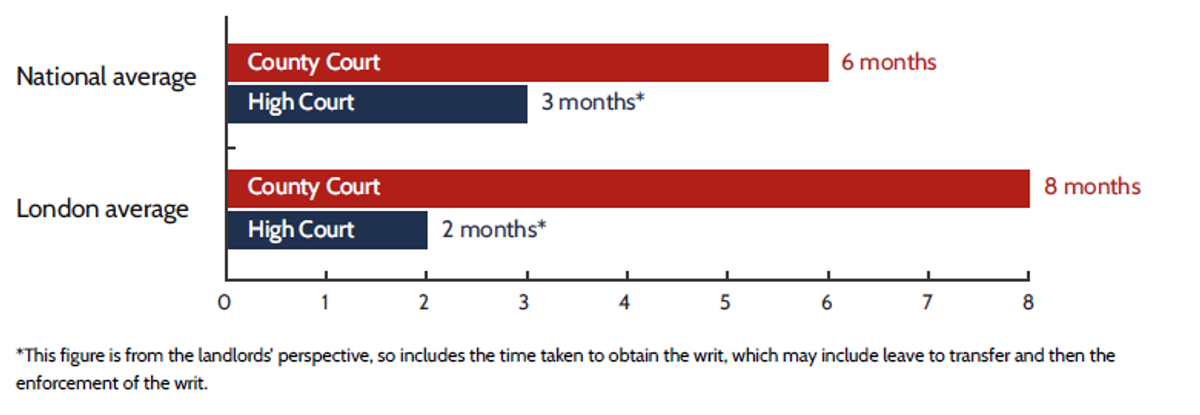Possession delays costing landlords thousands
By David Asker on
The High Court Enforcement Officers Association (HCEOA) has reported on the results of the survey they conducted with their partners the NRLA, Propertymark and Landlord Action, between May and July 2025.

There were 679 respondents, representing the landlords of over 52,000 properties in England and Wales.
Whilst the challenges faced by landlords (private, local authorities and social housing) when looking to recover residential property is widely known, this report shows that the extent and scale of the issue is significant and is negatively impacting the rented housing sector.
This impact is not just the loss of income to landlords, affecting their ability to pay mortgages on property, but also preventing others from moving into the property and therefore reducing housing supply.
In this article, we will cover the findings of the research, as well as the recommendations made to Government in the report.
You can read the full report on the HCEOA website.
The current situation
County Court Bailiffs (CCB) have traditionally been the route for the enforcement of an order for possession. A landlord may apply to the Court for permission to transfer up the order so they can use a High Court Enforcement Officer (HCEO) instead. The application is made under Section 42 of the County Courts Act 1984. The request is normally made at the same time as applying for the order for possession, but can be made after the order is granted.
The landlord will need to provide grounds for this request to be approved. Most commonly, the grounds are based on the delays through using the CCB and the additional loss of income and risk of damage to the property through anti-social behaviour.
It is at the judge’s discretion whether to permit the transfer up.
This is in stark contrast to the right to transfer up a county court judgment (CCJ) to the High Court for enforcement, where no permission (leave) is required.
Issues in the County Court Bailiff system
In 2024, according to the Mortgage and Landlord Possession Statistics, April – June 2025, there were 41,803 warrants of possession, of which 27,582 were enforced by an estimated 350 CCBs.
This is on top of the 212,407 warrants of control issued for enforcement by the same 350 CCBs.
At least one County Court is now quoting HMCTS policy as stating that CCBs will no longer be able to use reasonable force to evict the tenant” where necessary and recommending the use of High Court enforcement if appropriate.
Several survey respondents also commented on not receiving updates and therefore finding it difficult to arrange other contractors to attend at the same time as the CCB, especially as the CCB appointment set is often not enough time or when the CCB attends earlier than the eviction is booked for.
Average timescales
Nationwide, the average eviction waiting time through the County Court system is six months. This is on top of the often long delay to get the order for possession in the first place.
In London, once the order for possession is granted, the average CCB delays are eight months and, in many cases, over a year before the eviction takes place. Not surprisingly, landlords give a satisfaction rating of 2/10 for the County Court process in London.
Only 30% of landlord requests to transfer up in London are being approved. Reasons given for refusal provided in the survey are:
- There are “no delays” – 25% of requests in London are turned down for this reason
- Judge disagreeing with the option or citing “judicial guidance”
- Judge didn’t think the level of arrears (£14,000) was serious enough
- Judge saying the landlord would have to wait like everyone else
When using the High Court route, landlords state an average waiting time of three months nationally and two months in London. This includes the time taken to obtain the writ and service notice. It may also include the time to obtain leave to transfer.
Every HCEO taking part in the survey said they can typically set an eviction date within one month of the issue of the writ of possession.
Average eviction waiting time after a possession order has been issued
Resulting rent loss to landlords
The average rent loss before the landlord is able to gain possession is £12,708 nationally and £19,223 in London.
Using the average rental figures and delays in London, the HCEOA calculates that landlords could reduce their losses by over £12,000 by switching to High Court enforcement.
Impact on the housing sector
Local authorities and social housing providers are having to spend valuable time and resources chasing up eviction dates. They are unable to place tenants in property because they are waiting for an eviction.
Private landlords are finding the delays and additional costs are putting them under additional pressure, with many planning to exit the market.
This is supported by the Government’s English Private Landlord Survey 2024, where 31% of landlords reported planning to decrease the size of their portfolio in the next two years, including 16% who were planning to sell all their properties.
In 2021, the percentage of landlords planning to decrease the size of their portfolio was 22%. In 2018 it was 16%.
What is the solution?
The survey shows an unambiguous support for making the process for using an HCEO clearer and easier to enable landlords to recover property more quickly.
The HCEOA and its partners have put together a two-part plan which would incur no costs to any party:
- Engage with District Judges to ensure that the HCEO transfer up request should always be allowed where the local CCB delay is three months or more, or where reasonable force may need to be used
- Simplify the transfer up process for landlords and the County Court and for onboarding onto future Court digital reforms
Landlords can help as well by applying for leave to transfer up at the same time as requesting the order for possession and giving substantial evidence providing the grounds for the request in a witness statement. This could be evidence of delays, anti-social behaviour, increasing rent arrears, threats of confrontation or violence, which might mean the use of reasonable force may be required.
In terms of tenants, the HCEOA’s Code of Best Practice covers established procedures for engaging with vulnerable people and the same notice period and protections for tenants apply, whether enforcement is via the CCB or HCEO.
Fees are paid by the landlord, so are not an additional cost for the tenant being evicted.
Need help evicting a tenant?
Get in touch to speak to our team for advice on how to apply for leave to transfer up and enforce your possession order.
You can also download our complementary guide to private tenant eviction from our website.

David Asker
David is an authorised High Court Enforcement Officer and our Director of Corporate Governance

